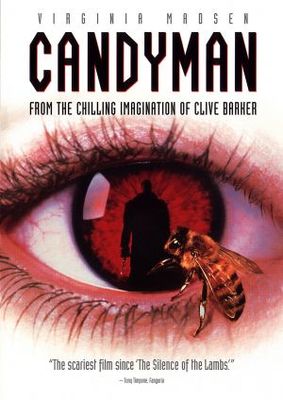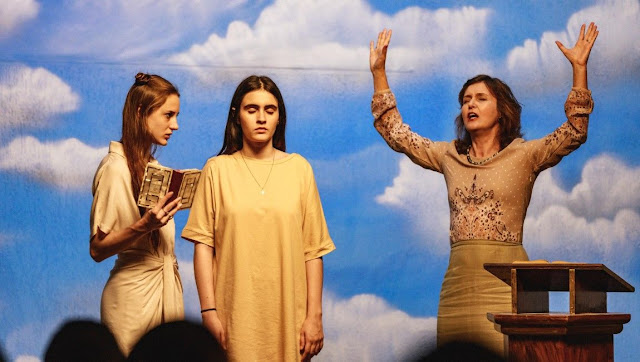Candyman(1992) | Timely Themes, Timeless Classic
"A-M: I heard her screaming
I heard her right through theses walls
I dialed 911. Nobody Came.
Nobody Came. Everybody's Scared.
He can come right through these walls, y'know
I'm-I'm Scared
Scared for my Child.
They ain't never gonna catch him.
H: Who?
A-M: Candyman" - Anne-Marie, 00:28:01
"NOT THE BEES. OH GOD NOT THE BEEEEEEEEEEES!" - The Wicker Man(2006)
Candyman is a horror film written and directed by Bernard Rose and was based on the short story "Forbidden" by Clive Barker. It was produced by Propaganda Films and Polygram Filmed Entertainment and was distributed by Tristar Pictures. It is available on Netflix. It stars the acting talents of Virginia Madsen(Helen Lyle), Tony Todd(Candyman), Vanessa Estelle Williams (Anne-Marie McCoy).
Every Society has its fears and every society creates stories to explain these fears, ( I.E Vampires can be interpreted as violent and decedent caricatures of the european ruling class or how are modern interpretation of zombies reflect our better understanding of germ theory and pathology). The urban legends that our whispered about between message boards and watercooler gossip serve the same function as the ghost stories and legends of yore but updated to fears we can relate to like razor blades in candy and serial killers in bunny suits. Urban Legends have had a long-standing tradition in horror cinema with one of the earliest adaptations being Foster's Release(1971), (One of the earliest adaptations of "The Call is coming from inside the house)*. There have been more recent films as well such as the eponymous Urban Legend(1998), (which dealt with a serial killer using various tales such as "Arn't you glad you didn't turn on the lights" and that whole bubblegum spider egg thing as his M.O), and Slender(2018), which seeked to interpret one of creepypastas most notable boogeyman. Candyman 1 uses both the concept of the urban legend as a manifestation of explaining society ill with the titular villain being botha scapegoat for violence and tragedy in the community and as a cautionary tale of the effects of racism.
Clive Barker's short story "Forbidden" dealt heavily with British social structure and featured a Candyman who was a sallow white. When Bernard Rose adapted the short story he drew upon America's own prejudices. Candyman has a heavy subtext of racial tension and discrimination throughout the film. Candyman is a lynch victim, Cabrini-Greens is a direct result of the effect of red-lining and much of the film calls out the White's fear of the "Superpredator" Myth as Anne-Marie says in the film:
"You say you're doing a study? What 'you gonna study? How we're bad? We steal? We gang-bang? We're ALL on drugs right?... We ain't all like them assholes downstairs, you know. I just wanna raise my child good."All this being said it is important to note that Candyman was written from a white perspective and not an Afro-Centric one. I myself found the movie to be a condemnation of racial prejudices 2 depicted however it is important to acknowledge that I like the majority of film critics and reviewers am a White Male and as a result can not comment with the same perspective as a POC who is affected by the issues addressed. That being said I recommend reading this article by Paul Gorman who does an excellent job at discussing the racial and socio-economic components of the film. Also given the importance of Own Voices in representative media I am excited to mention that Candyman is getting a 2020 sequel directed by Nia Decosta, a female POC, and written by Jordan Peele, (who created Get Out(2017), which dealt heavily with themes of racism). Now enough navel gazing and hand wringing let us get into the meat of the review.
As a blonde coed tells us a sordid story of a babysitter finding her lover murdered in the bathroom the cameras pans over to the calm and collected Helen Lyle, a woman on a mission to finish her dissertation, get her doctorate and tell all those white old guys in the folklore department to stuff it. Her topic of choice? Candyman, An African American Bloody Mary type with a hook for a hand. Helen goes from the White dominated world of academia to Cabrini-Greens, a housing project in a redlined neighborhood in Chicago. As she chases the story of Candyman the themes of the murders shifts from traditional White suburban urban legends and dry academic recitals of racial violence to ultra-violent crimes against members of the predominantly African American community. Everything is fine and dandy as Helen is developing film and being beat up my local gangsters until she meets the titular Candyman. One aspect of the first act I loved was its use of vignettes through the stories told to Helen as she seeks to unravel the legend. It provides an interesting narrative contrast to the main storyline and works well with a movie centered around the conceit of urban legends in general. The second act twist flings Helen into the role of an unreliable narrator as well as stripping her of credibility in her field of influence. Candyman while a slasher movie averts the traditional slasher formula. Candyman has a relatively small body count compared to other slashers (for instance Ghostface in Wes Craven's contemporary Scream(1996)), with Candyman's motivation stemming primarily with an obsession with a certain blonde chain smoking folklorist. The movie comes across more as a forbidden romance ghost story then the high octane murder fests of the mainstream slasher. While the plot may not be as cohesive as I would enjoy, (A common criticism is that Candyman, despite being a main character, is unnamed despite him having a known history), it lends itself to a well paced and enjoyable movie. I was not able to enjoy a thoroughly fleshed out lore for the ghostly killer but the story provided enough context to carry the story over its more confusing and slashery elements.
A centralized element of the movie was the dynamic between Virginia Madsen's and Tony Todd's characters. While it is never explicitly stated a romantic subtext perpetuates their scenes mirroring the interracial relationship that spurred Candyman's lynching. Helen's conflict is not only fighting against the action's and crime's of the ghost but also in her phantom paramour's deadly seduction. Madsen is a fantastic actress and her personality and interactions bring a great value to the movie overall but it would be an omission to discuss this movie without mentioning the nuanced chemistry of the two main leads. Another actress I would like to commend is Vanessa Estelle Williams, whose character, Anne-Marie, is depicted as a tragic figure. Williams depiction was provocative, realistic and gut-wrenching.
Anthony B. Richmond, (who interestingly enough also filmed Tales from the Hood(1995)), was the cinematographer for the movie. Architecture is a recurring motif throughout the filming from the aerial views of Cabrini Greens to the tonal shift from the heavily graffitied hallways to the warm inviting living room of Anne-Marie. Richmond provides a rich atmosphere to the movie whose locations which might appear mundane otherwise are giving life. Another interesting aspect of the film are short single frame clips of repeating visual motifs, (a gimmick that I also loved in the more recent Marianne), which provide a meta almost supernatural aspects to the scenes. Richmond provides a strong visual style and the movie as a whole is cinematically impressive.
In the other production corner many words of praise can be said for the work of Philip Glass who provided the score for Candyman and its sequel Candyman: Farewell to the Flesh(1995). Glass is known for his "minimalist" pieces which is a wonderful descriptor for his subtle but effective soundtrack. From the sounds of a church choir performing Gregorian chants or light piano trills provide an ephemeral and nearly ecclesiastic tone to the work. The music tone is almost operatic at times providing a theatrical edge to the overall dramatic film. Like all good movie scores in takes a backseat to the plot of the film while also providing an innocuous emotional weight.
Candyman is for lack of a better term a truly iconic movie. Subtle social commentary, strong creative style, and a strong chemistry between the two main leads provides a strong and innovative classic that is a must for any horror aficionado. As adaptations and localizations go this one takes the honey cake.
========================================================================
*The earliest urban legend movie appears to be The Midnight Warning(1932) which adapted the legend. The Vanishing Hotel Room. This urban legend spurred several other films in the '30s. The next string of urban legend movies was based on "The babysitter and the man upstairs" in the '70s
(1) I Didn't have a good place to put it in the article but I would like to spend a few words discussing the urban legend symbology of Candyman. Candyman is essentially the Syncretism of two earlier and prolific Urban Legends. Bloody Mary began as a type of divination ritual common in Victorian times where a young woman would walk backwards up a staircase holding a mirror while chanting Bloody Mary's name. If you were to die before marriage you would see her face but if not you would glimpse the face of your beloved. The legend over the years moved away from its divination origins and became more about seeing a spooky ghost in the mirror. There is no historical consensus on who "Bloody Mary" was or even if there is a historical basis for the story through common suggestions are Mary 1st of England, The historical Bloody Mary, Elizabeth Bathory, A Countess/Serial Killer, and Mary Worth, A Salem Witch. The use of saying Candyman, (which is said 5 times instead of the classical 3), mirrors the terror/horror intensity of the Bloody Mary legend, it's incredible easy to say the name the first 4 times but the last iteration the moment on the cusp of oblivion is where the true fear lies. Besides the ritual to summon Candyman special emphasis should be placed on his weapon of choice, The Hook. The Hookman Legends are a series of similar urban legends originating sometime around the 1950s generally involving an escaped mental patient with a hook for a hand. Like Bloody Mary the original legends are much more tame with subsequent retellings and variants being much more violent. Unlike Bloody Mary which had its start in European Folklore, The Hookman is a distinctly American Tale and is conceptialy an early progenitor to the Slasher archetype. Candyman is a combination of these two well known tales and as a result can resonate soundly to an American Audience.
(2) Quote from an interview of Bernard Rose where he describes a sensitivity screening with representatives from the NAACP:
"I had to go and have a whole set of meetings with the NAACP because the producers were so worried and what they said to me when they'd read the script was 'Why are we even having this meeting? You know, this is just good fun.' Their argument was 'Why shouldn't a black actor be a ghost? Why shouldn't a black actor play Freddy Krueger or Hannibal Lecter? If you're saying that they can't be, it's really perverse. This is a horror movie."


Comments
Post a Comment